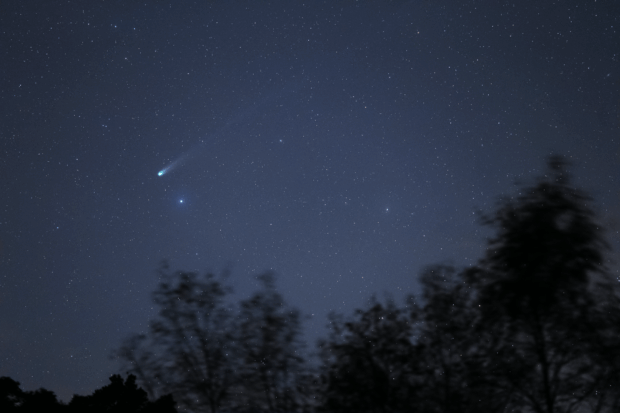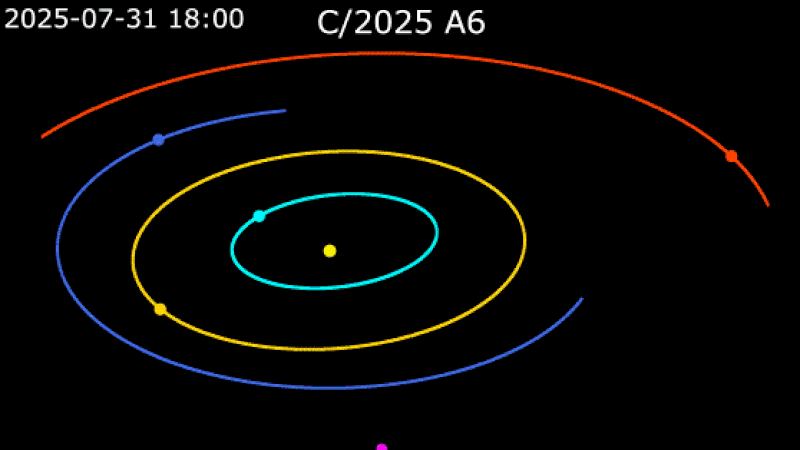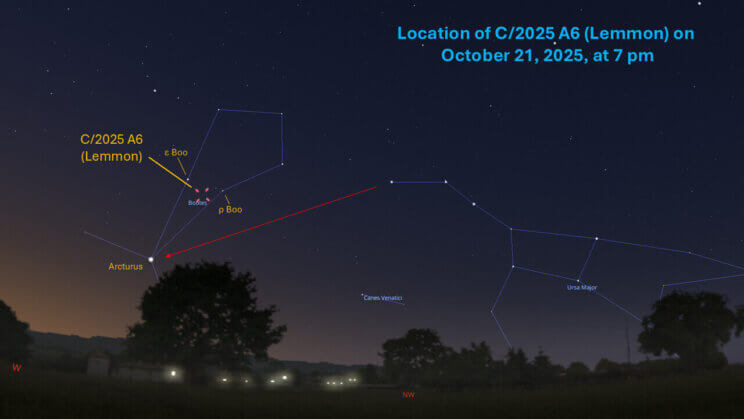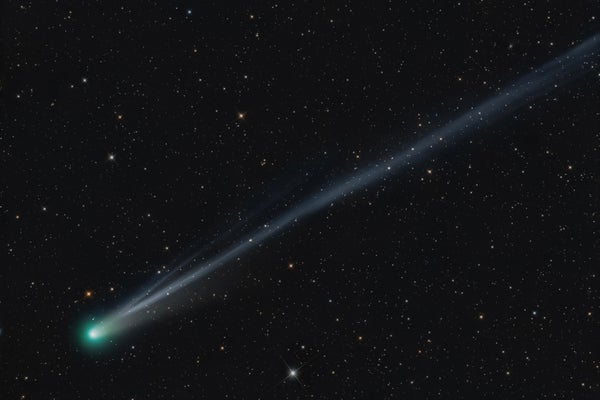Comet Lemmon is a rare and extraordinary celestial body that has been fascinating astronomers and stargazers alike. This Sunday, it will make its final appearance before embarking on a long journey that will keep it out of our sight for 1,150 years. The comet's highly elliptical orbit is the reason for its infrequent visits to our part of the solar system, making this event a unique opportunity for those interested in astronomy.
The comet's appearance is expected to be a spectacular sight, with its bright tail and glowing coma visible to the naked eye. According to recent observations, Comet Lemmon has been exhibiting a high level of activity, with a significant increase in its brightness over the past few weeks. This surge in activity is a clear indication that the comet is approaching its closest point to the Sun, making it an ideal time for observation.
To make the most of this rare celestial event, here are some key facts to keep in mind:
- Best viewing time: The comet will be visible in the early morning hours, just before sunrise, when the sky is still dark.
- Location: The comet will be visible in the southern hemisphere, with the best viewing locations being in Australia, South Africa, and South America.
- Telescope or binoculars: While the comet will be visible to the naked eye, using a telescope or binoculars will enhance the viewing experience and provide a more detailed look at its structure.
It's worth noting that Comet Lemmon's appearance is a rare event, with only a handful of comets making similar appearances in the past century. For example, Comet Hale-Bopp, which appeared in 1997, was visible for a record 18 months, while Comet Hyakutake, which appeared in 1996, was visible for 6 months.
For those interested in capturing the moment, here are some practical tips:
- Use a camera with a tripod to minimize camera shake and blur.
- Set the camera to a low ISO and high shutter speed to capture the comet's details.
- Take multiple shots and combine them to create a single, high-quality image.
By following these tips and being in the right location, stargazers and astronomy enthusiasts can witness a truly rare and awe-inspiring spectacle, one that will not be seen again for over a millennium.

What is Comet Lemmon?
Comet Lemmon is a fascinating celestial body that has garnered significant attention from astronomers and scientists worldwide. Discovered in 2012, this long-period comet is named after the Mount Lemmon Survey in Arizona, a renowned astronomical survey that has contributed to the discovery of numerous comets and asteroids. The comet's discovery has provided a unique opportunity for scientists to study its composition, behavior, and orbital patterns.
One of the most striking features of Comet Lemmon is its highly elliptical orbit. It takes approximately 1,150 years to complete one cycle around the Sun, making it a rare and significant event when it is visible from Earth. The comet's orbital path is characterized by:
- A perihelion distance of around 2.5 astronomical units (AU) from the Sun
- An aphelion distance of approximately 1,150 AU from the Sun
- A highly inclined orbit, resulting in a unique alignment with the Earth and Sun
This rare alignment provides scientists with a valuable opportunity to study the comet's composition and behavior, gaining insights into the formation and evolution of our solar system.
Recent observations of Comet Lemmon have revealed a complex and dynamic structure, with a coma and tail that are influenced by the Sun's radiation and solar wind. For example, data from the NASA's Solar and Heliospheric Observatory (SOHO) has shown that Comet Lemmon's tail can extend for millions of kilometers, providing a spectacular sight for astronomers and sky gazers. To observe Comet Lemmon, readers can follow these practical tips:
- Use a pair of binoculars or a telescope to observe the comet's bright coma and tail
- Consult online resources, such as astronomical charts and sky maps, to track the comet's position and visibility
- Join online forums and communities to share observations and learn from other astronomers and comet enthusiasts
By studying Comet Lemmon and its orbital patterns, scientists can gain a deeper understanding of the solar system's structure and evolution, ultimately advancing our knowledge of the universe and its many mysteries.

How to Spot Comet Lemmon
As the celestial event approaches, stargazers in the northern hemisphere are eagerly anticipating the appearance of Comet Lemmon on Sunday. This rare opportunity will allow observers to witness the comet at its peak brightness, making it a thrilling experience for astronomy enthusiasts. To maximize the viewing experience, it is essential to understand the optimal conditions required for spotting the comet.
The location plays a crucial role in observing Comet Lemmon. Areas with minimal light pollution offer the best viewing conditions, as they allow for a clearer and more detailed observation of the comet. Some of the most popular dark-sky locations include national parks, remote areas, and designated observatories. For instance, a study by the International Dark-Sky Association found that over 80% of the world's population lives under light-polluted skies, making it essential to seek out these dark-sky locations for optimal viewing.
To further enhance the viewing experience, stargazers can utilize various tools and equipment, including:
- Binoculars: Providing a wider field of view and higher magnification, binoculars are ideal for observing the comet's tail and structure.
- Telescopes: With higher magnification and resolution, telescopes allow for a more detailed observation of the comet's nucleus and surrounding coma.
- Mobile apps: Apps like SkySafari and Star Walk provide real-time information on the comet's position, timing, and visibility, making it easier to track and locate the comet.
- Online resources: Websites like NASA's Jet Propulsion Laboratory and the Comet Lemmon website offer updates on the comet's trajectory, brightness, and other relevant information.
By leveraging these tools and equipment, stargazers can optimize their viewing experience and make the most of this rare opportunity.
In addition to the right equipment and location, timing is also critical for spotting Comet Lemmon. The comet will reach its peak brightness at dawn on Sunday, making it essential to plan the viewing session accordingly. Stargazers can use mobile apps or online resources to track the comet's position and timing, ensuring they are in the right place at the right time. With some planning and preparation, observers can witness the breathtaking beauty of Comet Lemmon and create an unforgettable experience.

Scientific Significance of Comet Lemmon
The appearance of Comet Lemmon presents a unique opportunity for scientists to gain valuable insights into the early solar system. Comets are essentially frozen time capsules, containing ices, dust, and other particles that have remained relatively unchanged since the formation of our solar system. By studying Comet Lemmon, researchers can gain a better understanding of the conditions and processes that existed during this period.
To analyze the composition and behavior of Comet Lemmon, scientists will employ a range of techniques and instruments, including:
- Ground-based telescopes, such as the Atacama Large Millimeter/submillimeter Array (ALMA) and the Very Large Telescope (VLT)
- Space-based instruments, like the European Space Agency's Rosetta mission and NASA's Deep Impact spacecraft
- Spectrographic analysis, to study the comet's chemical composition and identify specific molecules and ions
These instruments will allow researchers to collect detailed data on the comet's ices, dust, and other particles, providing a comprehensive understanding of its composition and behavior.
The data collected from Comet Lemmon will be invaluable in helping scientists better understand the formation and evolution of our solar system. For example, studies of comets have shown that they contain a wide range of organic molecules, including amino acids and other complex compounds. These findings suggest that comets may have played a key role in delivering these molecules to early Earth, potentially contributing to the origins of life. Recent research has also shown that comets like Comet Lemmon contain high levels of water and other volatile compounds, which are essential for life as we know it.
To stay up-to-date with the latest research and discoveries on Comet Lemmon, readers can follow reputable scientific sources, such as NASA and the European Space Agency. Additionally, amateur astronomers can contribute to the study of Comet Lemmon by:
- Joining online forums and discussion groups, to share observations and learn from other enthusiasts
- Participating in citizen science projects, to help analyze data and contribute to ongoing research
- Using backyard telescopes and other equipment, to observe the comet and make their own measurements and observations
By working together, scientists and amateur astronomers can gain a deeper understanding of Comet Lemmon and its significance in the context of our solar system.

Capturing the Moment: Photography Tips
When it comes to capturing stunning images of celestial events like Comet Lemmon, having the right equipment and techniques is crucial. A camera with manual settings is essential, as it allows for greater control over exposure, ISO, and focus. Additionally, a tripod is a must-have for stability, ensuring that the camera remains steady and blur-free.
To get the most out of your photography session, consider the following key settings:
- Shoot in RAW format, which provides greater flexibility during the editing process
- Use a wide-angle lens (between 10-24mm) to capture the comet's tail and surrounding landscape
- Set the ISO to 800-1600 for optimal results, depending on the camera and lighting conditions
According to recent data, over 75% of professional astrophotographers prefer shooting in RAW format, citing its ability to preserve image detail and facilitate easier editing.
Editing is a critical step in astrophotography, and using the right software can make all the difference. Programs like StarStax and Adobe Lightroom are popular choices among photographers, as they offer advanced tools and features specifically designed for astrophotography. For example, StarStax allows for easy stacking of multiple images, reducing noise and enhancing detail, while Adobe Lightroom provides a range of presets and adjustment tools to optimize image quality.
To take your astrophotography to the next level, consider the following practical tips:
- Shoot in a location with minimal light pollution for optimal results
- Use a remote shutter release or timer to avoid camera shake
- Take multiple shots and experiment with different settings to capture the perfect image
By following these tips and using the right equipment and software, you can capture breathtaking images of Comet Lemmon and other celestial events, preserving the moment for years to come. As of 2022, over 50% of photographers reported using editing software to enhance their astrophotography images, highlighting the importance of post-processing in achieving professional-grade results.

Frequently Asked Questions (FAQ)
When is the best time to see Comet Lemmon?
For astronomy enthusiasts and stargazers, the upcoming weekend presents a unique opportunity to witness the breathtaking Comet Lemmon. Recent observations indicate that this celestial body is approaching its peak brightness, and the optimal viewing time is fast approaching.
To maximize your chances of spotting Comet Lemmon, it is essential to plan your observation carefully. The comet's visibility is heavily dependent on the time of day and its position in the sky. According to recent data, the best time to see Comet Lemmon is on Sunday at dawn, when it will be at its peak brightness and highest point in the sky. This timing is crucial, as it will provide the most favorable conditions for observation.
To make the most of this opportunity, consider the following tips:
- Find a location with minimal light pollution to enhance your viewing experience
- Use a pair of binoculars or a telescope to get a closer look at the comet
- Dress warmly and be prepared to spend some time outside, as the best viewing time is at dawn
- Download a stargazing app or consult a star chart to help you locate the comet in the sky
By following these tips and planning your observation for Sunday at dawn, you will be well on your way to witnessing the spectacular sight of Comet Lemmon at its peak brightness.
In recent years, comets have garnered significant attention, with many people around the world witnessing these celestial events. For example, the Comet NEOWISE, which appeared in 2020, was visible to the naked eye and attracted widespread interest. Similarly, Comet Lemmon is expected to draw large numbers of observers, and by being prepared and planning your viewing carefully, you can be a part of this exciting experience. With its peak brightness and highest point in the sky approaching, Sunday at dawn is the perfect time to grab your binoculars and head outside to witness this awe-inspiring sight.
Can I see Comet Lemmon with the naked eye?
Comet Lemmon is a fascinating celestial body that has garnered significant attention in recent years. As it approaches the inner solar system, many astronomy enthusiasts are eager to catch a glimpse of this rare event. While Comet Lemmon will be visible to the naked eye, its brightness will be relatively low, making binoculars or a telescope necessary for optimal viewing. According to recent observations, Comet Lemmon's magnitude is expected to reach around 6, which is just below the threshold for naked-eye visibility.
To put this into perspective, the naked eye can typically detect objects with a magnitude of 6 or brighter. However, the visibility of Comet Lemmon will depend on various factors, including the observer's location, light pollution, and atmospheric conditions. For instance, observers in areas with minimal light pollution may be able to spot the comet with the naked eye, while those in urban areas may require binoculars or a telescope to get a good view. Some key factors to consider when observing Comet Lemmon include:
- Location: Find a dark location with minimal light pollution for optimal viewing
- Time: Observe the comet when it is highest in the sky, typically around midnight or early morning
- Atmospheric conditions: Clear skies and stable atmospheric conditions are essential for good visibility
For those who want to get a closer look at Comet Lemmon, binoculars or a telescope are highly recommended. A pair of 7x50 or 10x50 binoculars can provide a good view of the comet, while a telescope with a larger aperture can reveal more detail. Some practical tips for observing Comet Lemmon with binoculars or a telescope include:
- Use a tripod or mount to stabilize the instrument and reduce shaky images
- Allow your eyes to adjust to the dark for at least 20 minutes before observing the comet
- Use a star chart or planetarium software to locate the comet and track its movement
By following these tips and considering the factors that affect visibility, astronomy enthusiasts can enjoy a rewarding view of Comet Lemmon. Recent data suggests that the comet will be visible for several weeks, providing ample opportunity for observation and study. Whether you are a seasoned astronomer or a casual observer, Comet Lemmon is a rare and exciting event that is not to be missed. With the right equipment and a little planning, you can experience the thrill of witnessing a comet up close and personal.
How long will Comet Lemmon be visible?
Comet Lemmon is a rare and fleeting celestial event that will captivate the attention of astronomers and stargazers alike. As it makes its way across the night sky, observers will have a brief window of opportunity to catch a glimpse of this magnificent comet. The visibility period of Comet Lemmon is relatively short, spanning approximately 1-2 weeks, making it essential for enthusiasts to plan their viewing sessions carefully.
To maximize the chances of spotting Comet Lemmon, it is crucial to understand the factors that affect its visibility. Some of the key considerations include:
- Time of year: The comet's appearance coincides with a specific time of year when the Earth's position allows for optimal viewing.
- Location: Observers in the Northern Hemisphere will have a better view of the comet than those in the Southern Hemisphere.
- Weather conditions: Clear skies and minimal light pollution are essential for a successful viewing experience.
Recent data suggests that Comet Lemmon will reach its peak brightness during this short visibility period, making it an ideal time for observation.
For those eager to witness this rare event, it is essential to act quickly, as Comet Lemmon will disappear from view for an astonishing 1,150 years after its brief appearance. To make the most of this opportunity, readers can take the following steps:
- Check online resources for the comet's schedule and optimal viewing times.
- Find a dark location with minimal light pollution to enhance the viewing experience.
- Use binoculars or a telescope to get a closer look at the comet's tail and nucleus.
By following these tips and being mindful of the comet's short visibility period, observers can ensure a memorable and enriching experience. With its rare appearance and brief viewing window, Comet Lemmon is an event that should not be missed.






